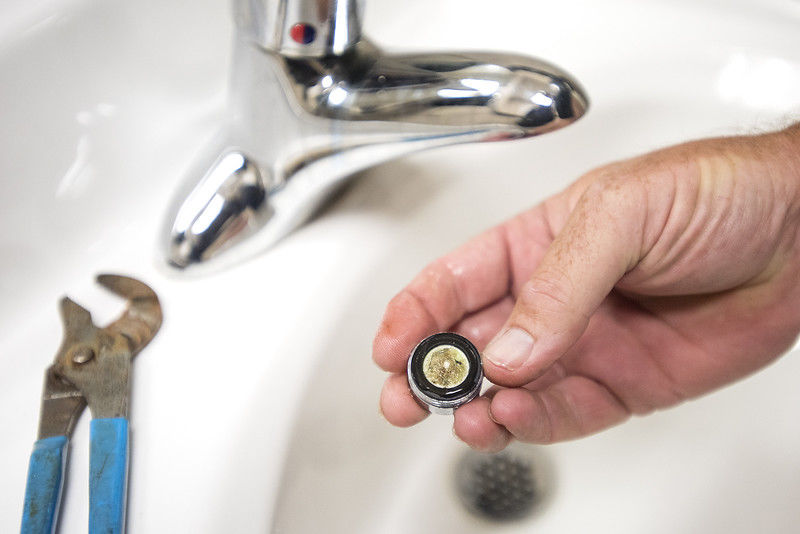Arp school officials scramble after asbestos found in town’s water
Published 8:28 pm Thursday, August 17, 2017

- Randal Wilson holds a filter, showing what's been collected in the filter, at Arp Junior High School in Arp, Texas, on Thursday, Aug. 17, 2017. The district purchased filtration systems for the cafeteria and drinking fountains and accepted a donation of four pallets of water from Ozarka in Hawkins to help out in the interim after they found out there was asbestos in the water. (Chelsea Purgahn/Tyler Morning Telegraph)
ARP – Superintendent Dwight Thomas started out his first day at school in a freshly starched shirt, but after a morning of delivering fresh drinking water to district campuses, both he and the shirt were soaking wet.
The official is worried about the safety of the local water supply after it tested positive recently for asbestos and he doesn’t want the people on his campuses consuming it.
Aging and collapsing municipal water lines are believed to be the primary culprit, affecting not just the school district, but also the entire town of 1,000 residents.
Arp’s mayor said state environmental experts just advised the city’s water is not hazardous, unless consumed over many years, but Thomas – who observed district flows range in color from muddy brown to slime green – said he’s not taking any chances.
“It smells like a sewer,” Thomas said Thursday, grimacing after turning on a faucet in the teacher’s lounge that released a methane-like odor into the room. “We don’t want our kids drinking it. This is a very unique situation and we’re going to deal with it the best way we can.”
A PROACTIVE RESPONSE
Providing potable water without a local source is proving challenging at best for the district, which serves more than 800 students across three campuses.
Nestle Waters North America in Hawkins stepped up last week and donated four pallets of its bottled Ozarka brand water, about 7,000 drink-sized portions, and the district is scrambling to secure larger containers from other sources to place throughout its facilities.
District maintenance also installed filtration systems in several key areas, including a designated faucet in the cafeteria and select water fountains, to ensure there are sources of purified water within the buildings, said maintenance director Randal Wilson.
Prior to the start of school, Thomas, who lives outside the affected service area, turned on his own taps to provide drinking water for students engaged in summer practices.
Parents were notified as early as possible about all these developments and thus far, seem appreciative of the efforts, the superintendent said.
“We’re trying to be proactive and do everything we can,” Thomas said. “Twenty years down the road, if someone develops health problems, I don’t want to be known as ‘that guy’ who didn’t do anything.”
Thomas said the district is especially grateful for Ozarka and other donors, but the current supply of bottled water is expected to last about two weeks as August temperatures kick up.
“I’m not much on asking for help,” he said. “We just need a plan for dealing with this issue. We want to be part of the solution until things get better. We’ll gladly take donations of water – just tell me where to come and I’ll come get it.”
CITY SEARCHES FOR SOLUTIONS
Arp Mayor Terry Lowry, who works for the school district as an educator and coach, is well aware of the concerns.
He’s been working for months with local, state and federal officials to figure out solutions, which won’t be cheap or easy or fast.
The problems stem from the fact that most of the town’s infrastructure is well past its prime, with some water lines dating back to the 1940s, the mayor said.
Arp City Council members agreed earlier this year to spend $1.4 million on fixing issues ranging from sinkholes and pipe leaks to outdated infrastructure, using funds from certificates of obligation.
City officials initially planned on refurbishing certain problem areas, using funds from grants, a local option for alcohol sales, a half-cent sales tax and a water rate hike.
But that was before a city worker noticed something unusual in the water in recent weeks and summoned officials to take a closer look.
Subsequent tests pointed to a type of asbestos.
The Texas Commission on Environmental Quality notified the town the level of asbestos exceeded the maximum score of seven for avoiding health problems. Sustained and prolonged consumption of the city’s water, which is ranked as a 13, could eventually cause intestinal polyps, according to an Aug. 2 letter posted on the city’s Facebook page.
The letter also indicated there was no need for residents to come up with alternative sources of water. However, it advised residents who have health concerns to consult with their physician.
Fixing the entire problem could cost a few million dollars, depending on the results of an assessment that’s now in the works. The mayor said there’s not enough money in the budget to cover the work.
And talks are underway with state and federal officials to see what funds, such as from grants or low interest loans, might be available to help the city attack the problem with a solution.
The city sent out letters and posted a notice on its Facebook page, alerting residents of this latest development in efforts to repair and replace 50-year-old pipes.
It may be weeks or even months before there are answers on how to fix the problem and how to pay for it.
“We don’t know what direction we’re going to take,” the mayor said. “We’ve known for a long time we’ve got an old system. Now we must do it (repairs) faster and do it all at once.”
TWITTER: @ TMT _ Jacque






